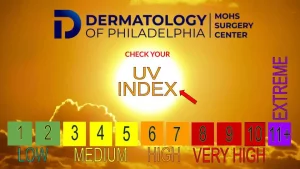- Dr. Mark Abdelmalek
- July 31, 2024
- 3:49 pm
Understanding the Ultraviolet (UV) Index can help protect your skin and eyes from harmful UV radiation, reducing the risk of sunburn, premature aging, and skin cancer.
What is the UV Index?
The UV Index is a forecast that tells you how strong the sun’s UV rays are when the sun is at its highest point in the sky (solar noon). It helps you know how much time you can safely spend in the sun and what kind of protection you might need.
The strength of UV rays depends on several factors, including the sun’s position in the sky, the amount of ozone in the atmosphere, and the cloud cover. The UV Index ranges from 0 (at night) to 15 or 16 (in tropical areas with clear skies).
When the sun is highest in the sky, UV radiation is at its strongest. As the sun moves towards the horizon, UV radiation decreases rapidly. The higher the UV Index, the quicker skin damage can occur and the more careful you need to be to protect your skin and eyes.
How to Find The UV Index in Your neighborhood?
The Environmental Protection Agency (EPA) calculates a daily UV index for each zip code. Click here to find the UV index for your neighborhood.

And modern technology, like smartphones and smartwatches, can give you daily UV Index information, helping you make smart choices about sun exposure. Your local weather station will often report the UV index for you as well.
What Does the UV Index Mean?
The UV Index scale measures the strength of the sun’s ultraviolet (UV) radiation. Here’s what the different numbers mean:
- 0 to 2 (Low): Minimal risk of harm from unprotected sun exposure. You can safely stay outside for longer periods without much protection. However, wearing sunglasses is still a good idea.
- 3 to 5 (Moderate): Moderate risk of harm from unprotected sun exposure. It’s a good idea to wear sunglasses, sunscreen, and a hat if you’ll be outside for an extended time.
- 6 to 7 (High): High risk of harm from unprotected sun exposure. Protection against sun damage is needed. Wear sunscreen, sunglasses, a hat, and seek shade during midday hours.
- 8 to 10 (Very High): Very high risk of harm from unprotected sun exposure. Extra precautions are needed. Wear protective clothing, a wide-brimmed hat, sunglasses, and apply sunscreen frequently. Try to avoid being outside during midday hours.
- 11+ (Extreme): Extreme risk of harm from unprotected sun exposure. Take all precautions possible. Avoid the sun between 10 a.m. and 4 p.m. If you must be outside, wear long sleeves, long pants, a wide-brimmed hat, and sunglasses, and use sunscreen.

Some UV Index Trivia to Impress Your Friends and Family!
- The UV index was first introduced by the US National Weather Service in 1994.
- Extreme UV indices (11 or higher) are often in the tropics, but can even be found in northern parts of the United States like Wyoming in peak summer!
- UV rays can be intensified by reflective surfaces like water, sand, and snow. Beachgoers should remember that sand can reflect UV and double your UV exposure. Same thing with snow on mountains during ski season- double!
- On a high UV Index day, you can get sunburned in as little as 15 minutes if you’re not protected.
What is the Difference Between UVA, UVB, and UVC rays?
There are 3 main types of UV rays- UVA, UVB and UVC. Each impacts the skin in a different way.
UVA rays contribute to skin aging- think “A” for “Aging”. They penetrate more deeply than UVB rays and contribute to wrinkles, the appearance of leathery skin and also increase the risk of skin cancer.
UVB rays affect the outer layers of skin more than the deeper layers. They cause sunburns- think “B” for “Burns”. They also increase your risk of skin cancer.
UVC rays are the most dangerous, but fortunately they are absorbed by the earth’s atmosphere and ozone layers and do not reach the earth’s surface.
Are You Safe from UV Rays in the Water?
While water does absorb some UV radiation, UV rays can reach below the water’s surface. UV rays can penetrate shallow water fairly well, meaning you can still get sunburned while swimming close to the surface.
Because the UV rays can reach around 3 feet under the water, it’s important to wear sunscreens that are water resistant while swimming. Choose a water-resistant sunscreen if you plan to swim or sweat. Water-resistant sunscreens maintain their SPF protection for 40 to 80 minutes while you are in water or sweating. And despite what a label may say, there is no such thing as a waterproof sunscreen.
How to Protect Yourself from UV-Related Problems?
By taking a few simple precautions, you can reduce your risk of sun-related illnesses.
- Limit your time in the sun between 10:00 a.m. and 4:00 p.m.
- Whenever possible, seek shade.
- Use a broad spectrum sunscreen with a Sun Protection Factor (SPF) of at least 30.
- Wear a wide-brimmed hat and if possible, tightly woven, full-length clothing.
- Wear UV-protective sunglasses.
- Avoid sunlamps and tanning salons.
- Watch for the UV Index daily.
What Sunscreen is Best to Protect from UV Rays?
Sunscreens labeled “broad-spectrum” protect against both UVA and UVB rays. By choosing a broad-spectrum, water-resistant sunscreen with a SPF of 30 or higher, and applying it correctly, you can effectively protect your skin from harmful UV radiation. SPF 30 blocks approximately 97% of UVB rays, while higher SPFs block slightly more.
Apply sunscreen generously 15-30 minutes before sun exposure to allow it to absorb into the skin. Reapply sunscreen every two hours, or more frequently if swimming or sweating, to maintain effective protection.



